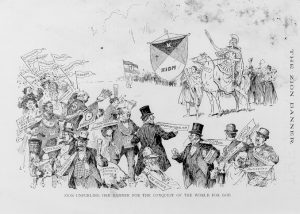In researching context for newspapers in the Illinois Digital Newspaper Collection I came across the fascinating history of Zion, IL, formerly Zion City, which was created as a utopian community in 1901 by an evangelical and early Pentecostal faith healer named John Alexander Dowie. In its early years the city did not allow drinking, dancing, smoking, card playing, theater, or even driving more than 10 miles an hour. Zion is a small town south of Kenosha and north of Waukegan in Lake County, Illinois. It is currently home to a nuclear power plant but boasts a rich history in American religious movements and utopian city planning.

John Alexander Dowie was born in Scotland in 1847; his family emigrated to Australia in 1860. He would later return to Scotland to attend the University of Edinburgh and study theology. Upon his return to Australia, he was ordained and became a pastor of the Congregational Church of Alma near Adelaide, Australia. He performed his first faith healing in 1877, healing a girl from an epidemic going around at the time. He broke with the Congregational Church in 1878 and founded his own church, the Free Christian Church. He was arrested for violating ordinances on street preaching and left Australia in 1888. After arriving in America and finding his preaching well received, he decided to stay. In America, there have been numerous examples of faith healers such as Joseph Smith (Mormonism), Ellen G White (Seventh Day Adventist Church), George Fox (Quakers), and Ann Lee (Shakers), amongst others.
He was called Dr. Dowie by his followers (despite no medical degree) and, in America, founded the Christian Catholic Apostolic Church (CCAC).
His following in America increased, and he began the periodical The Leaves of Healing in 1886, which circulated worldwide, bringing much attention to Dowie’s ministry and faith-healing practices. The Leaves of Healing contained healing testimonies and Dowie’s sermons and essays, which assisted in popularizing Dowie and the CCAC.
He set up a ministry near the 1893 World’s Columbian Exposition in Chicago. Dowie performed many healings and became a sensation following his healing of Sadie Cody, a niece of Buffalo Bill Cody, a celebrity of the era known for his Wild West Show.
He accumulated funds from the faithful and bought 6500 acres of land north of Chicago in Lake County for 1,250,000. (about 42 million in 2022). Dowie intended to create a planned utopia and publicized the new city in The Zion Banner.
The main industry of Zion was lace. Dowie bought lace machines from England along with lace makers. By 1906 at least 7500 people lived in Zion. Notably, most names of the streets in Zion, Antioch, Aquila, Berea, Damascus, Deborah, Ebenezer etc are biblical in origin to remind residents of the Bible constantly.
Dowie later went on to exploit his power and wealth, building a mansion for himself and his family costing 90,000$ or 3 million in today’s currency. Shiloh House, which remains in Zion and currently houses the Zion Historical Society, was a 3-story, 25-room mansion built using the modern European fashions.

Dowie suffered a stroke in 1905 and recalled Wilbur Glenn Voliva, a minister of the CCAC that Dowie had sent to establish a branch of the Church in Australia. Voliva assisted in a coup to oust Dowie from power due to financial mismanagement. Dowie was further accused of attempting to institute polygamy, his wife testified against him, and he was entirely discredited in the eyes of the public. He died in 1907, out of power.
Wilbur Glenn Voliva then took over Zion, writing his own beliefs in the Leaves of Healing, the Zion Herald, and, later, in a newspaper he founded, the aptly named Theocrat.
Voliva was considerably less popular than Dowie. Although he got the city into some financial order he alienated many of the people that had supported Dowie due to his personality and his insistence that the earth was flat. Voliva made the schools of Zion teach flat earth doctrine and issued a challenge to anyone to prove him wrong for 5000$ ( but only under the rules Voliva created.) A record of those opposed to Voliva’s changes appears in the Zion Independent, which was founded in protest of Voliva and grew to become the main newspaper for the Independent Party of Zion.
The Independent would eventually oust Voliva from power in 1937. Zion celebrated the separation with a new city sticker–a picture of global earth.
Today Zion is a small city north of Chicago, home to a large power plant. You can read more about the history of Zion at the History, Philosophy, and Newspaper Library, the Illinois Digital Newspaper Project, and the Illinois History and Lincoln Collections.
Cook, Philip L. Zion City, Illinois : Twentieth-Century Utopia. 1st ed. Syracuse, N.Y: Syracuse University Press, 1996.
Garwood, Christine. Flat Earth : the History of an Infamous Idea. London: Macmillan, 2007.
Soland, Randall J. Utopian Communities of Illinois : Heaven on the Prairie. Charleston, SC: The History Press, 2017.